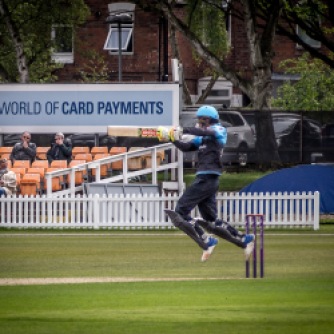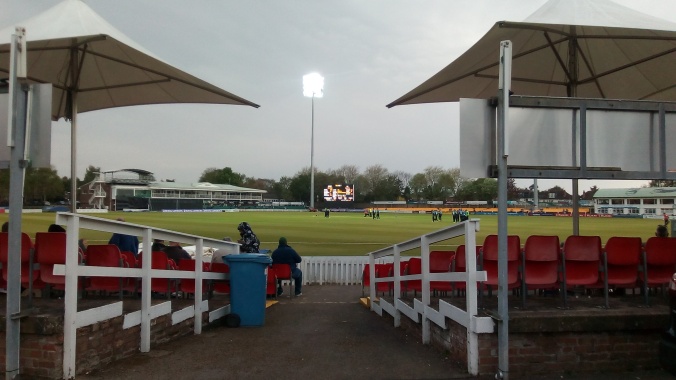Leicestershire CCC (312-8) lost to Derbyshire CCC (266-3) by DLS
Leicestershire CCC (261-9) lost to Northamptonshire CCC (290-6) by 29 runs
Leicestershire CCC (340) beat Warwickshire CCC (304) by 36 runs
All at Grace Road in the RL50, 24th April, 4th May & 6th May 2019

I was originally expecting to miss most of this competition through enforced attendance at Leicester Crown Court (I shall tell you about my secret life as a criminal mastermind another time)*, so that I managed to catch the majority of the home games lent a pleasing feeling of stolen pleasures to what might otherwise have been a forgettable and soon-forgotten series of games. Being among people who would not wish to be anywhere other than where they are is a mood-enhancing aspect of days at the cricket, but having something to contrast them with accentuates it : work used to do the job nicely, a few days in court worked well too.
I felt that there should have seemed something momentous about what were, it appears, likely to be the last series of one-day games to be contested by full county sides : the shades of Ted Dexter, David Hughes, Brian Langford and other luminaries should have hovered mournfully over the ground, softly lamenting golden days gone by – but not so.
The format of the one-day competition has been mucked about with so frequently over the last twenty or so years that there is now no sense of continuity about it. Supporters of the winning team in the County Championship are at least dimly aware that they are part of a line that stretches back to 1890 (or 1873, if you prefer) : if Somerset were to win it this year, their supporters would know that it would be for the first time. It is hard to say whether the RL50 is the inheritor of the old Gillette Cup, or the John Player League (or even the superfluous Benson and Hedges Cup, the one it most resembles in terms of format, and – this year – its iceland slot in April). Any fule kno that Yorkshire has won the most Championships : I doubt whether the most persistent badger could tell you who has won the most one-day trophies**.
The current format also meant that none of the competitors in Leicestershire’s last two home games had any chance of qualifying for the next round : not only was there a lack of dramatic tension, but Warwickshire, at least, jumped the gun on fielding a ‘development’ team by omitting most of their senior players.
I am not certain, in any case, how many of those who turned up for the ‘Family Fun Day’ on the Saturday, or even the Bank Holiday Monday game, would have been aware of the ECB’s plans for next season, or that they were witnessing a mildly historic occasion. They were trying bravely, in the face of mild hostility from the weather (the most consistent performer in this year’s competition was N.E. Wind), to have a good day out for a pound, and I imagine they’ll be back next year too, ‘development competition’ or not, as long as one side is billed as ‘Leicestershire’, there are enough juvenile distractions, and Towcester cheesecake still for tea. We all dream of the platonic day at the cricket (in whatever form), and we are not that easily discouraged.
Leicestershire saved their really abject defeats for the away games, so a purely home supporter’s impression of their performance would not have been be too unfavourable : two wins, two defeats (and neither by shameful margins). The Derbyshire game was one that I was expecting to miss in its entirety, but managed to catch the Leicestershire innings : given the confidence with which the forecasters had predicted rain, I was not expecting there to be a Derbyshire innings, and I’m not sure they did either. When I had to leave, they seemed to be taking care to keep slightly ahead of the DLS target (helpfully displayed on the scoreboard) : in the event, I believe, the rain did arrive, but cleared unexpectedly, and Derbyshire were left to scramble for their win off the last ball, as if they had arrived early for a train, but had lingered too long in the café. They had lost only three wickets, and only one to a Leicestershire bowler.
In the innings I did see, Leicestershire had made 312-8, 119 of them by Colin Ackermann, who currently looks to belong in a different class to his colleagues (perhaps the one that will be drafted into ‘The Hundred’). Harry Dearden will have been disappointed to make only 36 (not a sentence I could have imagined writing a year ago), and Aaron Lilley hit two successive sixes, in an innings of 23 that would have been better suited to a T20, before knocking down his own wicket. Otherwise, Leicestershire’s batsmen mostly brought their own demise against a motley attack, which began with Wayne Madsen’s sluggish part-time off-spin, joined by two teenage seamers and some more batting than bowling all-rounders, whom Captain Godelman shuffled almost by the over, perhaps to create the impression that he had more bowlers than there really were.
The Northamptonshire game (which had been chosen for the Family Fun Day) saw the reappearance of Mohammad Abbas, whose return has been awaited with the fervour that messianic sects reserve for the return of their saviour. He bowled well enough, if a little in need of a squirt of WK40. It also saw the disappearance of Paul Horton, replaced as Captain by Colin Ackermann : I have not dwelled on Horton’s form, but, although he may still have a few fifties left in him, I would not be surprised if the replacement became permanent in other forms of the game in due course.
Northants, who batted first, fielded a potentially explosive top three in Vasconcelos, Levi and Cobb (no longer in the Mr. Creosote sense, in Levi’s case, as he seems to have slimmed down a little). Dieter Klein, whose effectiveness can decline the longer he bowls, bowled Vasconcelos in his first over, and Levi, rumbling like Vesuvius, drove Abbas straight to mid-off. Josh Cobb, in the ‘it’s-the-way-I-play’ style we remember well from his days at Grace Road, tried to silence Stench’s airhorn with a massive hack at Klein, when on one : unfortunately, the only sunlight of the day happened to be in Harry Dearden’s eyes, and he was dropped, as he was in similar fashion by Mike when he had made two.
Having been dropped twice, Cobb continued to menace low-flying birds, with some success, until a firmly hit drive was plucked from the air by Harry Munsey, the young Scotsman who had been drafted in to replace Paul Horton (his most significant achievement in the two games he was to play). Captain Wakely, who had steadied his ship after the early turbulence, was LBW to Callum Parkinson, who was flighting the ball nicely, and must have been relieved to bowl so economically, after some of the pastings he took last year.
During the most significant partnership of the day, of 156 between Keogh and Tom Curran, more of the crowd were inside than out, coinciding, as it did, with a hail storm, and the height of the ‘fun’ (including a display of exotic animals in the Bennett End bar, to rival the usual one in the Fox Bar). It also coincided with lunch time, and I am not ashamed to say that I spent most of it in The Meet enjoying another Lewis Hill Burger. My view of the action was largely obscured, but whatever Keogh and Curran were doing on the field was obviously effective.
By the time Leicestershire began their reply, the hail had cleared, the temperature was merely uncomfortably chilly, and the families, beginning to tire of the ‘fun’, were drifting home for tea : by the fifth over, with only 15 runs on the board and both openers gone, anyone desperate for a home win must have been tempted to follow them. There are sides, packed with middle-order ‘gun bats’, who would have been capable of simultaneously consolidating and accelerating from such a poor start, but ours are low-calibre, and, in spite of some worthy contributions from Ackermann, Taylor and Mike, the total traipsed along behind the required run-rate, at a respectful distance, to a 29 run defeat.
The final game, against Warwickshire felt more like a foretaste of things to come than a fitting end to the one-day era. Warwickshire were lacking Bell, Ambrose, Hain, Brookes, Sidebottom, Norwell, Stone and Woakes (some through injury) : Leicestershire, mindful that another defeat would be a blow to morale, fielded their first choice team. The crowd was meagre for a Bank Holiday : some, no doubt, deterred by the deadness of the rubber and the absence of stars, but most, I’d guess, by the greyness of the skies and the lack of sun.
The bulk of Leicestershire’s 340 runs came from the three batsmen who have most impressed this year. The word ‘imperious’ does not naturally attached itself to Harry Dearden, but there was something of that quality about his handling of the seamers, whom he punched blithely through the covers on his way to 69. He is, understandably, more wary of spin, and was characteristically unlucky to receive the ball of the tournament from Jeetan Patel, one which Dearden quite reasonably expected to hit leg stump (if that) but straightened to removed his off peg instead.
Ackermann’s 74 came as no surprise, and it took Patel himself to remove him. I had no idea that Tom Taylor was such an accomplished batsman (I’ll refrain from saying the same about Dearden), and it was only a piece of low comedy that prevented him making a maiden century. A straight drive to take him from 98 to 100 was deflected by the bowler on to non-striker Parkinson’s stumps, bringing last man Mohammad Abbas to the crease in the last over. Abbas may be one of the world’s ten best bowlers, but he is also one of the ten worst batsman, and was bowled before he could return the strike to Taylor.
Warwickshire opened with Sibley and Pollock, like a greengrocer putting his best fruit at the top of the pile to conceal the lower quality produce beneath (not that the batsmen to follow were rotten, just mostly unripe). Unusually, it was not clear until about the twentieth over who was going to win. The openers began fluently, but Sibley was cut off in full flow by a toe-crusher from Klein, and Pollock, the man most likely to accelerate the scoring above the required rate, was bowled by a ball from Parkinson that Jeetan Patel might, in other circumstances, have appreciated .
Rob Yates, however, an auspicious 19-year-old debutant, seemed worryingly at ease with the bowling, and was only removed by fellow youth Ben Mike inadvertently obstructing him as he turned for a second run, when on 66. After that, the innings began to run down like a clockwork rabbit powered by cheap batteries, and with it the match, and the competition.
Given that Leicestershire had narrowly shaded Northants for the wooden spoon, that ending felt surprisingly hopeful. Morale will not have been broken, as we turn gratefully to an extended period of Championship cricket : apart from Ackermann, Dearden and Taylor, Klein finished as the leading wicket-taker, Lewis Hill made a century, Ben Mike had a few good moments and Parkinson bowled well enough to have had a better return. Mark Cosgrove’s form is the major concern : that opening salvo against Worcestershire now looks less like a man in the form of his life than one trying to bluff his way out of a slump.
Looking forward to next year, I am not sure that the prospects for one-day cricket are too bleak, from a purely selfish point of view (I understand why supporters of the larger counties would not agree) . Although, in the long term, I think the advent of ‘The Hundred’ can only damage the smaller counties (indeed, that may be one of its primary purposes), in the short term, a competition stripped of its stars will, at least, improve Leicestershire’s chances of winning. It will also be nice for T20 deniers to have some cricket to watch at the height of Summer, when the prospects of a wind-free day of ‘Family Fun’ will also be increased.
Anyway, I am sure it will be a lot more enjoyable than being in prison.
* Actually, jury service.
** For the record, it’s Lancashire, with 16.













































